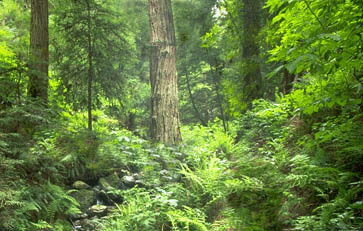
|
Oak Woodland Biozone
First posted February 1, 2004 Last updated
November 15, 2011
| You may have taken a walk along the road above camp and noticed that the area is very different from the majority of Caz. There are fewer redwoods and they are smaller and farther apart, and the canopy is not defined by redwoods. |
 |
| The most common tree is the tanbark
oak, a broad-leafed tree about 20
feet tall. Mixed in are some Douglas
fir, but they tend to be small. There
are also many other plants growing below the branches
of the oaks. So many that you can't even walk
through the forest. This is the Oak Woodland Biozone.
The classical Oak Woodlands are typically covered
with blue, black, valley, coast live, or interior
live oaks. However, our Oak Wooland has many similar
characteristics with the classical Oak Woodland
and is very different from our redwood forest.
(See footnote) |
This biological area is much more diverse than the
redwood forest, because the trees do not filter out
all the sunlight, as the redwoods do. There is a well-developed
understory of ferns,
poison
oak, flowers, and shrubs. This plant diversity
also promote a greater animal diversity, as they have
more to eat here. The tanbark
oak (not technically an oak, as it is not in the Quercus family) produces a nut (not technically an
acorn, either, but only the scientists can tell the difference)
that is eaten by deer, squirrels, turkeys, wild pigs,
many insects, and other animals.
This is the area you are most likely to find an alligator
lizard down in the leaf litter looking
for insects and spiders.

Other Biozones:
Redwood Forest
Biozone
Riparian Biozone
Chaparral Biozone
Grasslands Biozone

Note
I had a very hard time coming up with a name for this
biozone. Classically, the redwood
forest biozone is divided into three forms
(see Redwood Forest),
and then further subdivided into plant communities.
The region that I am referring to here is a plant community,
which is a classification smaller than a biozone. According
to the book, Coast
Redwood: A Natural and Cultural History,
which I most highly recommend, less than 15% of the
redwood forest plant communities have been fully described.
I have selected the name for this zone based on its
own special characteristics, as explained above. It
does not fit the alternative names, such as Redwood/
Mixed Evergreen Forest (higher elevation, large amounts
of Douglas-fir), or Redwood/Douglas-fir Forest (slopes
adjacent to Redwood Forest is accurate but our area
has relatively little Douglas-fir in the upper stories
of the canopy). I feel that this name best describes
the forest above the access road.
|

|

